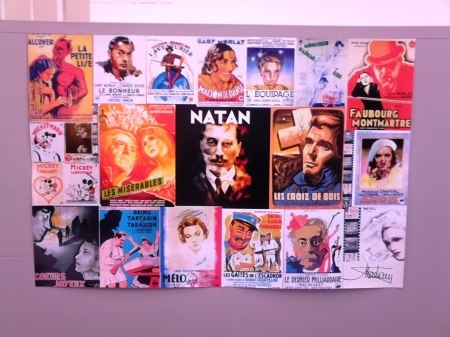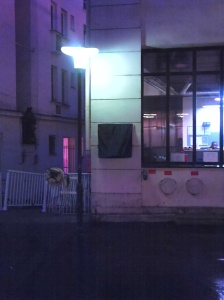Getting back to Edinburgh on Thursday, I returned to work the following day to see a talk by Jan Harlan, Kubrick’s brother-in-law and producer, director of the Malcolm McDowell documentary O LUCKY MALCOLM! etc (pictured above with Head of Film & TV Emma Davie).
Harlan is a delightful fellow, and the theme of his talk — music in cinema — was one he was well-qualified to discuss having worked with Kubrick on all his scores from 2001 on, and having an extensive knowledge of classical music. The wide range of film clips he presented illustrated how music can be used as a storytelling tool, to control the pace, to enhance character and to generally beautify the film. Harlan was, in effect, proselytizing for classical music and suggesting that all filmmakers should study it and fall in love with it. “If you don’t love it, you’re likely to ruin it,” was his mantra. And, “If you want to know how you acquire ownership of art, it’s very simple: you just fall in love with it and it becomes yours.”
It’s a huge and tricky subject. My advice has often been to never use a piece of music you know from another film. TV magazine shows do this — so that you couldn’t escape PULP FICTION’s surf guitar for at least a year on TV — and many documentaries do this, because to a large extent documentaries haven’t learned to take themselves seriously as art — hence they recycle titles from other movies, or slightly adapt them, which otherwise only porno movies do. There are exceptions to my rule — years before Kubrick made the Blue Danube his own, Julien Duvivier had used in memorably in THE GREAT WALTZ, where obviously you couldn’t avoid it, but more excitingly, Clouzot had used it with great imagination in THE WAGES OF FEAR, where Yves Montand slewed his truck all over the road in waltz time. But Kubrick had confidence that he could trump those films, and he was right.
But when that plinky-plonk bit of Carl Orff that forms the theme of BADLANDS gets used in TRUE ROMANCE and MONSTER, the filmmakers don’t think they’re superceding BADLANDS. They’re just copying BADLANDS. And the thinking seems to be, “Young couple, road movie, murders, therefore we need the music from BADLANDS.” Absurd. The deliberate placing of your film in second-best position. A failure of imagination. A dive into the mediocre.
Harlan’s suggestion to study the field is sound advice, because filmmakers have exhibited a dreadful tendency to repeat the same few pieces of the repertoire until they become unsuitable for any use save parody. Barber’s Adaggio is an obvious victim (David Lynch used it beautifully before PLATOON, and when Harlan showed the PLATOON clip I was struck by the obscenity of it — whose tragedy is this music expressing? As the American soldiers burn a Vietnamese village and separate civilian families, we are being asked to feel sorry for the soldiers, the poor youth of America who are being corrupted by violence). Lahkme by Delibes has been done to death not just by Tony Scott, who in fairness obviously loved the piece, but by everyone else who can’t be bothered selecting something less hackneyed (Brian DePalma and CARLITO’S WAY, stand up).
The counter-argument to Harlan and Kubrick’s suggestion that the best music ever composed is all available to us, is that it may be the best music but is it right for the film you’re making? It’s notable that FULL METAL JACKET uses not only considerable original score, performed by Kubrick’s daughter on the Fairlight synthesiser, the rest of its music is period-appropriate pop of a particularly and deliberately moronic nature (I like some of those songs a lot, but taken as a group I think they’re making a not-too-subtle comment of the dumbness of pop culture). Maybe PLATOON and APOCALYPSE NOW forced Kubrick’s hand — using classical pieces would have invited invidious comparisons — but I think Kubrick’s ultimate decision also skirts the western-centric solemnity and false dignity that could come from pasting high culture all over barbaric acts.








